 |
-Established 1997-

page updated: 3/17/98
| Divx:
Beyond the Hype A First Look at a Divx Player |
Introduction All right, all right... I know what you're all thinking. Based on my previous comments here on the Bits, you're probably expecting me to soundly lambast Divx in this article. You're not alone - in fact, the first thing Josh Dare (Divx's Director of Communications) said to me as he shook my hand was, "A lot of people have warned me about you. You're not as mean as I expected." To be honest, I had reservations about the meeting myself. As I admitted to Josh from the beginning, I've long been critical of Divx, in terms of both the format itself and its negative effect on DVD. How would my readers respond if, after all these months of criticism, I opened a dialogue with 'the enemy'? Me, the creator of the 'FREE DVD/FIGHT DIVX' logo, seen on many sites around the Internet. Me, the author of the tongue-in-cheek DVD Press Release? Would they think I'd turned to the Dark Side? Upon further consideration, however, my fears abated. It occurred to me that, for all the intense coverage in the press, for all the double-talk and ambiguous press releases, for all the frustrating studio posturing and blistering discussion on the Internet... we still didn't know that much about Divx. Aside from a few closed-door sessions, few people have even seen it. The hardware is still in beta-testing. The oft-mentioned test market period is still at least a month away. And those dreaded disposable discs are nothing but vaporware at the moment. With that in mind, I decided it was time to learn more about Divx for myself - firsthand and up-close. Hopefully, the experience would allow me to base my opinions on fact, rather than fiction. And more importantly, I'd hopefully be able to give all of you (who, judging by the heat you've been generating with your calls, letters, e-mails and boycotts, are VERY concerned about Divx) your first decent look at the format. So, I began making calls to Divx and Circuit City's corporate offices. After a few tries over a period of a couple of days, I was rewarded with a call from the aforementioned Josh Dare. I carefully explained my position to him, and my purpose. He explained that he was rather new to Divx, and was more than a bit daunted at all the hostility he's been experiencing as a result of his new position. But I found, to my pleasant surprise, that Josh was more than willing to provide me with information, answers to my questions, and press materials about Divx. I also quickly discovered that Josh was really a decent guy - helpful, genuine (lacking in that "whoever you are, you're probably not worth my time" attitude of suspicion, that's so prevalent in Hollywood) and certainly among the nicest people I've met in the industry. After a number of conversations, Josh mentioned that he would be in L.A. soon, and asked if I'd like to see an actual Divx player myself. How could I resist? What follows is as impartial an account of that experience as I'm able to give. I've tried to set aside my previous disdain for Divx, and not be unduly influenced by Josh's kind assistance. Certainly, the information below won't answer all of your questions about Divx (and may, in fact, only raise more). But at least it's a first, tangible look at the format. I'll wrap up with a few of my own comments at the end of the article. The Meeting I saw my first Divx player on Friday, March 13th (of all days!) at the L.A. offices of Ziffren, Brittenham, Branca & Fischer, the very entertainment law firm where it all began. Josh met me in the lobby and, after a brief conversation, led me into a large conference room where the demonstration took place. The player was connected to a standard 32-inch television on one side of the room. The conference room was also equipped with strategically placed speakers for surround sound. The player itself, I'm told, was one of the first five fully-functional prototypes built. A Zenith / Inteq model (specifically identified as a DVX-2100 Digital Versatile Disc Player), it had all the standard face controls one would expect to find on a normal DVD player. |
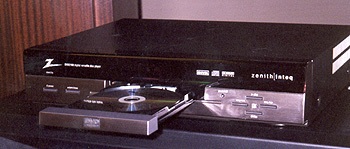 |
In fact, the first thing that first struck me about the player, was the innocent-looking DVD Video logo, featured prominently on its sliding disc tray. A small Divx logo was visible next to the Compact Disc and Dolby Digital logos (see below), sharply emphasizing the fact that the manufacturers (who support Divx) really do seem to view it as an added feature of DVD, instead of as a separate format. |
 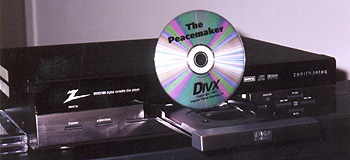 |
Inspection of the back of the player, revealed standard composite and S-video outputs (the S-video being used for the demonstration) and the expected phone jack (disconnected during the demo), as well as the usual audio outputs. A standard remote control was provided. As for the software present, there were about a dozen discs in evidence (four separate movie titles and a demo disc among them, as well as duplicate copies). |
 |
The titles available were: The Peacemaker, Liar Liar, George of the Jungle, and The Ghost and the Darkness. All appeared identical to normal DVD discs, save the Divx logo on the front (NOTE: I was told that these were demo discs, so the Divx logo used on them is the older one. The newer, rectangular logo will apparently be used on actual production discs). As expected, the discs were packaged in standard CD jewel cases. Two mock-ups, of the final packaging that will likely be used, were also present for Liar Liar and The Ghost and the Darkness. I was not allowed to photograph them (due to issues having to do with studio concern for the use of talent likenesses), but I can at least describe them here. The plastic face on both case's spines were clear, with a brown insert (showing the Divx logo) inside. In the place the CD booklet would normally be found, was a simple, one-sided paper insert, displaying the movie title and artwork. The top and right sides had a brown border, again displaying the Divx logo. The movie studio logo was on the lower left corner. There was no DVD logo visible on either the packaging or discs. Josh selected The Ghost and the Darkness, and inserted it into the player. A disc 'loading' screen appeared momentarily, followed by a logo screen, that identified the disc as a Divx disc (I was told that a normal DVD disc would skip this screen. Again, the newer logo will be used on actual production discs, instead of the older one seen here). |
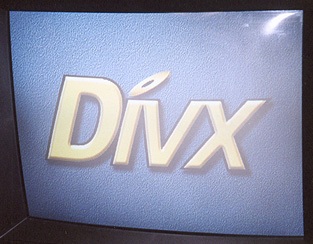 |
Shortly thereafter, a no-frills menu screen appeared that identified the name of the movie, and allowed a choice of selections: Movie Settings, Play Movie and Purchase Unlimited Play. Note that the player automatically defaults to Movie Settings. The decision to start the movie must be made consciously (by selecting Play Movie), thus preventing the inadvertent beginning of the 48 hour viewing period. Movie Settings allows you to select your viewing options just like a DVD. These options will be few, however, with Divx discs (more on that later). Once you've started your viewing period (played the movie at least once), this menu has an additional option: View Movie Status. This allows you to see how much time remains in your viewing period (NOTE: I was told that the player will not cut off the movie in mid-play, if your viewing period ends while you're watching it. The player will allow you to finish the movie). The Purchase Unlimited Play option allows you to convert a normal Divx disc into a Divx Silver disc (all Divx Silver discs start as normal Divx discs). The expected cost of a regular Divx disc at retail will be $4.50. Individual reviewings will run about $3.25 (a price which, I was told, may drop to $3.00 by the time Divx comes to market nationwide). The Divx Silver conversion price will be set by the studios ($12.49 was the price quoted by the player for demo purposes only). Once the disc has been converted, the View Movie Status screen will inform you that the disc is now a Silver disc, available for unlimited play on any Divx player on your account. The movie will now play automatically whenever the disc is inserted in one of your players. |
 |
Your Divx account is established when you bring your player home. Prior to first use, you call Divx and give them your credit card number for billing purposes. Your new player is then registered to your account. I was told that there is no limit to the number of players that can be registered to your account. If you pass the disc to someone with a player that's not on your account, they pay only the $3.25 reviewing fee, not the original $4.50. Note that individual Divx discs are identified and tracked by the players, via a barcode (visible on the disc's inner ring). After moving through the various initial options, we selected Play Movie. The Ghost and the Darkness started up as expected, in Pan & Scan, with 5.1 Dolby Digital surround sound. The player's response time was a bit slow, but I was told that this is true only of the early demo players - actual production models will operate smoothly. The video quality was surprisingly poor. There were numerous artifacts present in the picture - a kind of constant video noise. It's important not to make too much of this, however. All of the discs present were non-production demo discs. Many of you will recall just how bad some of the early DVD demo discs were. Based on Josh's statements, and my own experience, I have no reason to believe that the final Divx discs will look any different than DVD discs, in terms of video quality. What is interesting to note, however, is that artifacting I observed was completely different from anything I've seen on DVD before. I would liken it to a sort of rain-dropping effect throughout the picture, rather like watching rain splatter on a window. Whether it was simply caused by poor mastering, or is a result of the constant process of decrypting the coded data on the disc, was uncertain and remains to be determined. As for disc features... well there weren't any. I was told that all Divx movies will feature Pan & Scan only, with English 5.1 surround as determined by the studios (English-only subtitles will be available for the hearing impaired). The menus are extremely basic - no film artwork, no snap-shots of the film's various chapter stops. Chapter stops were selectable, but only from a basic numbered list. No 16x9 enhancement, trailers or extras of any kind will be included on Divx discs. And there are currently no plans now, or in development, to expand these features (although I was told that there has been some recent interest, on the part of the studios, to add at least widescreen). Which brings me to Divx Gold. I was told, in no uncertain terms, that Divx Gold is only different from a normal Divx disc, in that it is purchased as an unlimited play disc right at the retail outlet. It acts as an unlimited play disc on any Divx player, regardless of which account the player is registered to. According to Josh, there is currently no truth to the rumor that Divx Gold will function as a vehicle for special edition Divx releases, with extra features like those found on most DVDs (although this could, admittedly, be reevaluated). It is merely designed as a sell-through disc for those who prefer it. Because of this lack of features, Divx Gold discs will probably be priced slightly lower than the cost of DVD discs. The prices and availability of Divx Gold discs will be determined by the studios. Back to the player. Just like a normal DVD player, the Divx player has a Setup Menu, selectable using the player remote. |
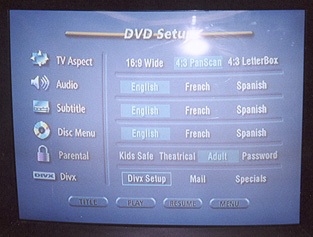 |
Among the selectable options are: TV Aspect, Audio, Subtitle and Disc Menu. These are designed to accommodate the full range of features currently found on standard DVD discs (again all Divx discs will use only 4:3 Pan & Scan and English audio & subtitles). A Parental feature allows you select the level of child viewing protection you want enabled. Of particular note is the Password option. This allows you to input, enable (and change) a custom password, that is used to restrict viewing, renting or Divx Silver conversion activity on your player. This feature apparently is a response to the concern, by many consumers, that kids or baby-sitters might ring up heavy viewing charges without adult supervision. The Divx options allow you to view your account information: player registration number, your account number, and up to three months worth of viewing / rental information (so you can keep track of what's been watched and when). The Specials section allows you to view special offers that may be made by individual studios (for example, a month-long price reduction in the cost of renting Star Trek films on Divx, in conjunction with the release of the latest Trek film to theaters). The Mailbox feature is another much-discussed aspect of Divx players. This allows Divx to send you news and information as they deem appropriate. These messages can be targeted to Divx consumers by individual zip code, so that (for example) Divx can inform you if a new local store in your neighborhood is now carrying Divx discs. |
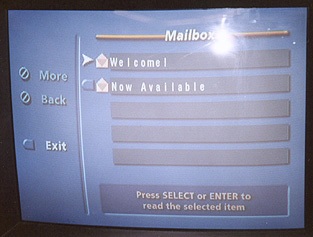  |
That's the Zenith / Inteq DVX-2100 Divx player in a nutshell. The Zenith player is expected to be the only player used during the test period, which is still scheduled for April, in two markets that have yet to be officially announced. Currently, a number of Divx employees are beta-testing players, software and the Divx computer system. As for other manufacturers and players, an RCA model is expected to be ready by summer, followed shortly thereafter by a Panasonic player. JVC and Pioneer models are expected in early 1999. As you know, Fox, Paramount, Dreamworks SKG, Universal and Disney have all signed on to release Divx titles. According to Josh, a sixth studio, an additional manufacturer and Divx's retail partners are expected to be announced in the next few weeks. As for movie titles, in addition to those already announced (see DVD News - Divx for a full list), I was told that Titanic will be available on Divx in the fall, day & date with VHS (there was no word on whether this title would be exclusive to Divx). Josh told me that Divx believes their format can coexist nicely with open DVD, adding an additional viewing option for consumers. He admits that the timing of the initial Divx announcement (last fall) was terrible, but unavoidable. And apparently, Divx made a number of attempts to create after-market upgrades for existing DVD players, but the costs were such that it would have been as expensive to upgrade as to just buy a new player. One of the things I mentioned to Josh, was that the biggest concern most people have about Divx, is the possibility that some films will only be available on Divx, and not on open DVD. Certainly, until Fox and Paramount announce otherwise, it seems inevitable that there will be Divx-only titles. Josh's response: "Divx is not trying to prevent studios from doing open DVD. Our contracts are not exclusive, and our model does not depend on Divx-only titles." But, Divx's position is that, without Divx, some of these titles might never have appeared on any digital video disc format. "If Divx increases the studio's comfort level to release their films digitally, that's good for everyone. Let's all work together to grow the digital marketplace." My Thoughts First of all, I'd like to thank Josh Dare, and the folks at Divx, for letting me have a closer look. Given my historical stance on Divx, that took some courage. I also look forward to continued access to Divx materials (hardware and software) and information, so that both I and my readers can continue to base our opinions about Divx on fact. You're probably wondering, what do I think of Divx now, after having seen it up-close. Well, I have to admit that Divx is clever. Whether you like it or not, it's an ingenious idea, and a lot of effort has been made to work out the bugs. But do I think Divx will work? No, I don't. For all the hype and the money and the studio support, it just asks too much of the average American consumer. Divx is targeting people who are mostly movie watchers. People who rent movies rather than buy them, and who are largely uninterested in collector's editions with lots of features. The problem is, this need is already being met nicely by VHS. People can record movies off cable & pay-per-view on VHS, and they can rent tapes at their local video store. These people are unlikely to pay the $100-200 premium a Divx player will fetch, for the ability to rent movies on disc. This is particularly true if they've as yet passed on DVD because of its higher cost. As for convenience, DVD is already there, and with loads of extras to boot. Many video rental stores are beginning to carry DVDs, as the market continues to grow. Blockbuster is expected to roll out a nationwide DVD rental program in the fall. And heck, I'm told (by friends there) that you can already rent DVDs in Fargo, North Dakota. When something begins to take off there, that's a sure sign that it's catching on with a larger consumer audience. The other problem with Divx, is that it asks consumers to completely change their thinking about ownership. When people pay for something, and take it home for good, they believe they own it. They reasonably expect that its use is unrestricted - that it can be used whenever and whereever they choose, without additional charge. The only things people pay for continuously (and don't expect to own) are utilities like electricity, phone service and cable TV. How many people do you know, who like their power company, their phone company or their cable company? How does Divx expect the average consumer to like the idea of owning the physical disc itself, without having the right to view the movie on it without paying more? Divx might claim, "But that's where Divx Gold comes in. It works just like a regular DVD." So why buy Divx over DVD? After viewing Divx up-close, it strikes me as... well, boring. What makes DVD so exciting are all the extras - the flash, the whiz-bang, the sheer value (feature-by-feature) you get for your dollar. Divx is like DVD... without all of the cool things that make DVD worth buying in the first place. My feeling continues to be that Divx, in the end, benefits itself and the studios more than anyone else. I still can't shake the feeling that Divx has more to do with creating a continuous revenue stream to the studios, than preventing digital piracy, or providing added convenience to consumers. And as long as Divx's existence prevents us from buying that awesome DVD special edition set of the Star Wars films, or an anamorphic widescreen DVD collector's version of Titanic, it will continue to be a serious annoyance. As always, I invite your comments. Bill Hunt, Editor The Digital Bits |

 |
| Site
designed for 1024 x 768 resolution, using 16M colors and .gif 89a
animation. © 1997-2015 The Digital Bits, Inc., All Rights Reserved. billhunt@thedigitalbits.com |